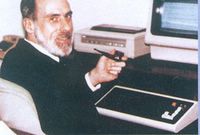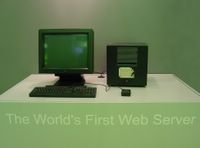When did the Internet era arrive in the Netherlands? That is difficult to say, as it is rather unclear when Internet started internationally. Part of the problem is also the definition: what do you mean by internet (generic system) or Internet (specific system). Before giving a background to the arrival of internet in the Netherlands, I will sketch the historical development of internet.

Vincent Cerf, co-author of the Transmission Control Protocol
Internet history usually starts with a reference to ARPAnet (Advanced Research Projects Agency Network), a military network of the United States, started in 1962 by the American Airforce under Paul Baran. The network eventually broadened to universities. On October 29, 1969 2004 the first Internet message was sent from computer science Professor Leonard Kleinrock's laboratory at UCLA, ushering in a new method of global communications. E-mail software for the network was developed on this net by Ray Tomlinson. Links to the American systems are made from the University College in London and Royal Radar Establishment in Norway. By 1974 the term internet is used by Vincent Cerf and Bob Kahn, who constructed the Transmission Control Protocol (TCP in 1974) and the Internet Protocol (IP in 1978) over the years. In 1983 ARPANet is split up in a military part and a civil part. The civil part was indicated as Internet. By 1987 The American National Science Foundation started the NSFNet, a network between five supercomputers, which eventually in 1989 replaces ARPANet as backbone. This can be considered as the start of the expansion of Internet worldwide as an academic and civil network.

The Next computer on which Tim Berners-Lee developed the World Wide Web, on show during the WSIS, World Summit on the Information Society, in Geneva in 2003 (collection Jak Boumans)
But a network is not enough. Of course it great to have a fast network for sending e-mails. But sending and retrieving information was rather primitive. So in 1989 Tim Berners-Lee put a plan on paper for the World Wide Web at the research institute CERN in Geneva (Switzerland). Central in the proposal was hypertext, a method to couple textual and visual information instead of structuring the information hierarchically or according to the tree structure. Berners-Lee expanded hypertext to hyperlinks. The program proposal for a browser achieved three components: a standard mark-up language, a Hypertext Mark-up Protocol to communicate between different browsers and a unique Uniform Resource Locator for the information provider. By the end of 1990 the first version of the browser was ready to be used within CERN. When a page did not exist a message indicated ERROR 404. According to the myth an error message would go to room 404 in CERN, which did not exist. By the summer of 1991 Tim Berners-Lee and CERN launched the World Wide Web.

One of the first browser screens of CERN (compliments of Mr Arie van Praag, CERN)
At once all kind of retrieval and browser programs started to pop up. In 1991 Gopher was launched, a program to visit online libraries. By 1993 the free web browser Mosaic was developed by Marc Andreesen, shortly followed by the commercial browser Netscape, which could be freely downloaded by users. It was the beginning of the worldwide advance of Internet. When Microsoft saw the impact it realised that it made the wrong bet and started to develop Internet Explorer, which was given free with the operating system Windows. Eventually Netscape lost and was bought by AOL.
Without the development of World Wide Web the NSF net would just have been a competitor of commercial networks like Sprint. The World Wide Web has given the worldwide impulse to internet.

No comments:
Post a Comment